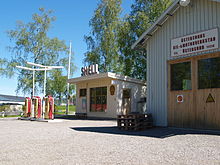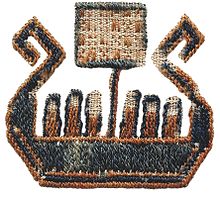Jamtli
Jamtli is the museum of the Swedish province of Jämtlands län ( Swedish Jämtlands länsmuseum ) in Östersund . It largely consists of an open-air museum dedicated to the history and culture of the historic provinces of Jämtland and Härjedalen . The museum consists of a museum building with a permanent exhibition and temporary exhibitions and an outdoor area with historical buildings. Living history projects under the title Jamtli Historyland have been carried out since the 1980s . This has helped make the museum one of the most famous tourist attractions in the area.
history
Jamtli's roots go back to the Jämtland Antiquities Association founded in 1866. After a long period of preparation under the direction of Ellen Widen, the provincial governor's wife, the open-air museum was inaugurated in 1912 and Eric Festin became its first director. In the early years the focus was on the collection of exhibits and historical buildings. In addition, courses in folk dance, music and handicraft were offered. The aim was to keep traditions alive that were in danger of being forgotten in the course of industrialization. This happened against the ideological background of romantic national historism , which was widespread throughout Europe in the 19th century.
The museum has published its Järnten yearbook since 1913 . At the end of the 1920s, the construction of a museum building began. Until then, the exhibits were shown in the historical buildings of the museum and in various places around the city. The new museum building was based on the castle architecture of the Vasa period of the 16th century. The museum was opened in 1930 with exhibitions on textiles, archaeological finds as well as works of art and objects of folk culture. The main attraction was the Överhogdal tapestries from the late Viking Age. The archaeologist , feminist and wife of the provincial governor Hanna Rydh played an important role during the 1930s . Her main interest was the traditional costumes of the region.
From 1953 to 1979 there were dancing events on Wednesdays in the outdoor area. These began as a family event, but over time they appealed to more and more young people. This had unpleasant side effects in the last few years of the event: The site was devastated and the historic buildings had to be protected with barbed wire. In the 1960s, restoration of the buildings and a realignment of events were inevitable. Folklorist Göran Rosander was appointed the new museum director in 1967. He knew how to increase the number of visitors with a large number of new exhibitions and ethnological excursions in the area.
In 1971 Sten Rentzhog became director of the museum. During this time the museum opened up to new learning methods and new reflections on the role of a museum in society. Buildings and exhibits were no longer viewed solely as dead relics from a bygone world, but included in the museum's daily activities. Since 1986, actors have populated the historical buildings in the summer and show visitors how people used to live and speak. This event, called Jamtli Historyland , soon became a major attraction and was the model for other events such as Jamtli Winterland in February and March.
The museum today
In 1990 the construction of a new museum building began. Five years later it was inaugurated with a series of new exhibitions on the cultural history of the historic provinces of Jämtland and Härjedalen. The previous building now houses offices, a library, one of Sweden's largest collections of historical photographs and the archeology and building maintenance departments.
The showpieces of the museum are still the tapestries from Överhogdal from the end of the Viking Age, which show the rich imagery of Scandinavian and Christian culture. A separate exhibition is dedicated to the mystical sea monster Storsjöodjuret from Lake Storsjön in Jämtland .
Henrik Zip Sane has been the museum director since 2002 . Under his leadership the European orientation of the museum was promoted and the museum took part in a number of projects with partners from all over Europe. The museum has been awarded several prizes, including the Great Tourism Prize ( Stora Turismpriset ) and the 2006 Children's Tourism Prize ( Barnens Turistpris ).
See also
Web links
Individual evidence
- ↑ Jamtli Historieland (Jamtland.se) ( Memento of the original from August 20, 2010 in the Internet Archive ) Info: The archive link was inserted automatically and has not yet been checked. Please check the original and archive link according to the instructions and then remove this notice.
- ↑ Jamtli Museum, Östersund, Sweden (Worklab)
- ↑ Jamtli Historieland (Östersund Turist & Kongress) ( page no longer available , search in web archives ) Info: The link was automatically marked as defective. Please check the link according to the instructions and then remove this notice.
Coordinates: 63 ° 11 ′ 11 ″ N , 14 ° 38 ′ 9 ″ E




